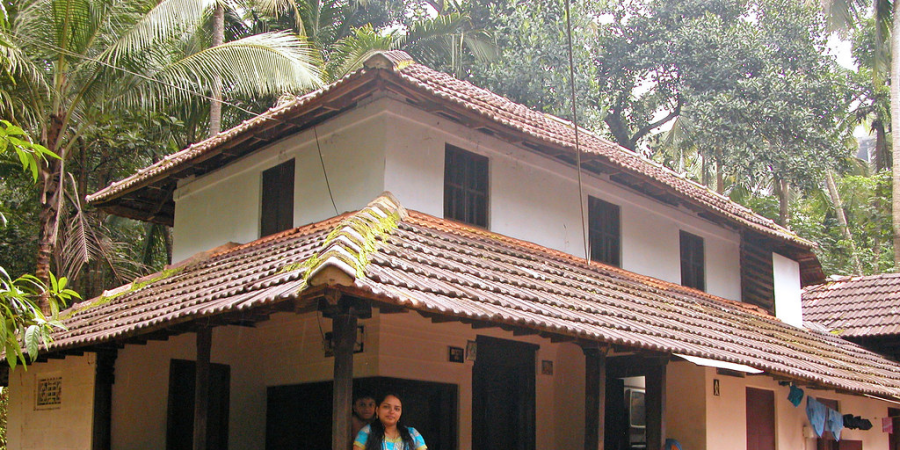

Tharavadus, traditional ancestral homes in Kerala, India, represent more than mere architectural structures. They are embodiments of Kerala's social, cultural, and familial values, especially among Nair and other matrilineal communities. These ancestral homes held unique importance in Kerala’s traditional society and were the center of community life, family identity, and legacy.
The word "Tharavadu" is derived from the Malayalam language, loosely translating to "ancestral home" or "family house." It represented not only the physical space of the family but also an entire lineage, with family members belonging to the same tharavadu identified through a shared ancestral name, or "house name." Tharavadus housed joint families, a significant social structure in matrilineal communities like the Nairs, Ezhavas, and select Muslim and Christian groups in Kerala, where property and lineage were traced through the mother.
Tharavadus were traditionally built with a keen sense of architecture, often consisting of large, extended buildings with multiple courtyards (nalukettu or ettukettu, depending on the number of courtyards). These structures were typically made of laterite stones, wood, and clay tiles, built to adapt to Kerala's tropical climate, with sloped roofs to manage monsoon rains. Each Tharavadu followed the principles of Vastu Shastra, the ancient Indian science of architecture, ensuring the structure was harmonious with nature and the cosmos.
The design reflected the importance of family hierarchy. The oldest male or the Karanavar (head of the family) would typically reside in the main room, while other family members, including children, women, and sometimes even servants, occupied other rooms according to seniority and function. The layout included an open courtyard for communal gatherings, rooms for prayer, and kitchen and storerooms. The central courtyard was often open to the sky, symbolizing openness and the cosmic connection.
In the traditional Kerala society, Tharavadus were more than just homes; they were centers of family lineage, heritage, and responsibility. The marumakkathayam system, a matrilineal system unique to Kerala, entrusted the Tharavadu with its properties and family inheritance, which would be managed and passed down through female descendants. In this system, inheritance passed from a mother to her children, with the eldest male, often the maternal uncle, holding the primary responsibility for managing family affairs, marriage arrangements, and finances.
The Karanavar played a vital role in maintaining the Tharavadu as a whole, uniting generations of family members, and upholding its traditions and values. This collective living allowed members to share resources, food, and responsibilities, fostering a sense of unity, mutual support, and shared values among extended family members. The Tharavadu acted as a socio-economic unit, often owning land, employing laborers, and serving as an influential institution in the community.
During the late 19th and early 20th centuries, Kerala underwent social and legal transformations that contributed to the gradual decline of the Tharavadu system. One of the main factors was the shift in inheritance laws. In 1925, the Madras Marumakkathayam Act formalized property division among the matrilineal communities of Kerala. By the time the Kerala Joint Family System (Abolition) Act came into effect in 1975, the joint family system was officially abolished, and property rights were equally distributed among family members. This act dealt a final blow to the concept of a collective family estate managed by a single Tharavadu, causing the partition of properties and the breakup of families.
Urbanization, modernization, and migration also played significant roles in eroding the Tharavadu system. Younger generations moved to cities and foreign lands in search of education and better economic opportunities, leaving their ancestral homes behind. Additionally, with increasing nuclear family structures, many Tharavadus lost their functionality, either falling into disrepair or being sold or demolished for redevelopment.
While the Tharavadu system no longer exists as it once did, Kerala’s people and government have taken steps to preserve its legacy. The Kerala Department of Archaeology, along with various heritage and cultural organizations, have begun to identify, restore, and protect historic Tharavadus as cultural heritage sites. Some prominent Tharavadus have been converted into museums, homestays, and cultural centers, where tourists and locals alike can experience Kerala’s rich heritage.
Many Malayali families, even those residing outside Kerala, continue to cherish their Tharavadu identity, preserving family traditions and celebrating festivals that evoke the essence of these ancestral homes. Some have established family trusts to maintain the physical structures, ensuring that future generations can connect with their heritage.
The history of Tharavadus in Kerala illustrates the deep-rooted familial and cultural values that define Kerala's unique heritage. Tharavadus, as ancestral homes, held not only physical space but also the essence of family, tradition, and matrilineal kinship. Although the traditional system of Tharavadu has largely faded due to legal reforms, social changes, and modernization, the spirit of these ancestral homes remains alive in Kerala’s cultural consciousness. Tharavadus continue to symbolize a connection to heritage, family pride, and a way of life that valued unity, resilience, and shared responsibilities.
